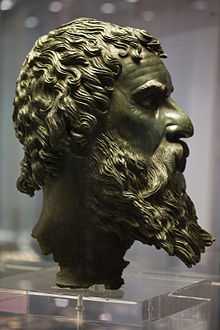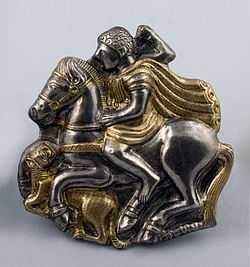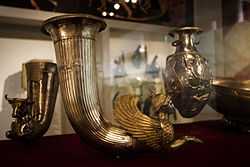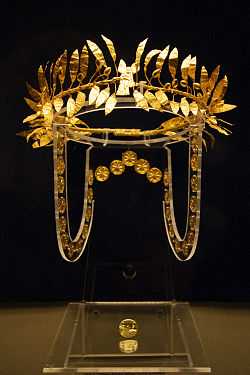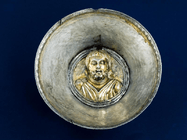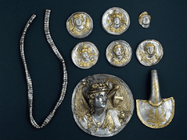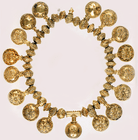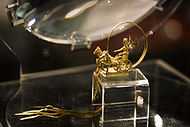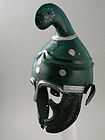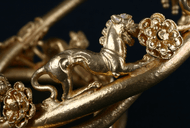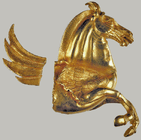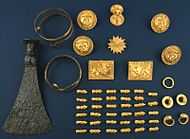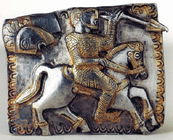Thracians
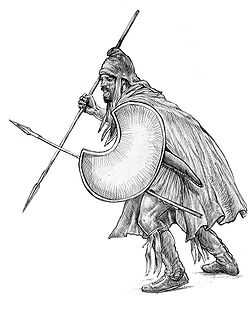
The Thracians (/ˈθreɪʃənz/; Ancient Greek: Θρᾷκες Thrāikes, Latin: Thraci) were a group of Indo-European tribes inhabiting a large area in Southeastern Europe.[1] They were bordered by the Scythians to the north, the Celts and the Illyrians to the west, the Ancient Greeks to the south and the Black Sea to the east. They spoke the Thracian language – a scarcely attested branch of the Indo-European language family. The study of Thracians and Thracian culture is known as Thracology.
Etymology
The first historical record about the Thracians is found in the Iliad, where they are described as allies of the Trojans in the Trojan War against the Greeks.[2] The ethnonym Thracian comes from Ancient Greek Θρᾷξ (plural Θρᾷκες; Thrāix, Thrāikes) or Θρᾴκιος/Ionic: Θρηίκιος (Thrāikios/Thrēikios), and the toponym Thrace comes from Θρᾴκη/Ion.: Θρῄκη (Thrāikē/Thrēikē).[3] These forms are all exonyms as applied by the Greeks.[4]
Mythological foundation
In Greek mythology, Thrax (by his name simply the quintessential Thracian) was regarded as one of the reputed sons of the god Ares.[5] In the Alcestis, Euripides mentions that one of the names of Ares himself was "Thrax" since he was regarded as the patron of Thrace (his golden or gilded shield was kept in his temple at Bistonia in Thrace).[6]
Origins and ethnogenesis
The origins of the Thracians remain obscure, in the absence of written historical records. Evidence of proto-Thracians in the prehistoric period depends on artifacts of material culture. Leo Klejn identifies proto-Thracians with the multi-cordoned ware culture that was pushed away from Ukraine by the advancing timber grave culture. It is generally proposed that a proto-Thracian people developed from a mixture of indigenous peoples and Indo-Europeans from the time of Proto-Indo-European expansion in the Early Bronze Age[7] when the latter, around 1500 BC, mixed with indigenous peoples.[8] We speak of proto-Thracians from which during the Iron Age[9] (about 1000 BC) Dacians and Thracians begin developing.
Identity and distribution
Divided into separate tribes, the Thracians did not manage to form a lasting political organization until the Odrysian state was founded in the 5th century BC. A strong Dacian state appeared in the 1st century BC, during the reign of king Burebista. Including the Illyrians, the mountainous regions were home to various peoples regarded as warlike and ferocious Thracian tribes, while the plains peoples were apparently regarded as more peaceable.
Thracians inhabited parts of the ancient provinces of Thrace, Moesia, Macedonia, Dacia, Scythia Minor, Sarmatia, Bithynia, Mysia, Pannonia, and other regions of the Balkans and Anatolia. This area extended over most of the Balkans region, and the Getae north of the Danube as far as beyond the Bug and including Panonia in the east.[10]
History
Archaic period
These Indo-European peoples, while considered barbarian and rural by their refined and urbanized Greek neighbors, had developed advanced forms of music, poetry, industry, and artistic crafts. Aligning themselves in kingdoms and tribes, they never achieved any form of national unity beyond short, dynastic rules at the height of the Greek classical period. Similar to the Gauls and other Celtic tribes, most people are thought to have lived simply in small fortified villages, usually on hilltops.
Although the concept of an urban center was not developed until the Roman period, various larger fortifications which also served as regional market centers were numerous. Yet, in general, despite Greek colonization in such areas as Byzantium, Apollonia and other cities, the Thracians avoided urban life.
The first Greek colonies in Thrace were founded in the 8th century BC.[11]
Thrace south of the Danube (except for the land of the Bessi) was ruled for nearly half a century by the Persians under Darius the Great, who conducted an expedition into the region from 513 BC to 512 BC. The Persians called Thrace Skudra.[12]
Classical period
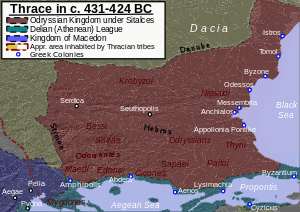
In the first decade of the 6th century BC, the Persians invaded Thrace and made it part of their satrapy Skudra. Thracians were forced to join the invasions of European Scythia and Greece.[14] According to Herodotus, the Bithynian Thracians also had to contribute a large contingent to Xerxes' invasion of Greece in 480 BC.[14] Subjugation of Macedonia was part of Persian military operations initiated by Darius the Great (521-486) in 513 - after immense preparations - a huge Achaemenid army invaded the Balkans and tried to defeat the European Scythians roaming to the north of the Danube river.[15] Darius' army subjugated several Thracian peoples at the same time, and virtually all other regions that touch the European part of the Black Sea, such as parts of nowadays Bulgaria, Romania, Ukraine, and Russia, before it returned to Asia Minor.[15][16] Darius left in Europe one of his commanders named Megabazus whose task was to accomplish conquests in the Balkans.[15] The Persian troops subjugated gold-rich Thrace, the coastal Greek cities, and defeated the powerful Paeonians.[15][17] Finally, Megabazus sent envoys to Amyntas, king of Macedon demanding acceptation of Persian domination, which the Macedonian accepted. At this time, many if not most Thracians fell under Persian rule.[15]
By the 5th century BC, the Thracian presence was pervasive enough that Herodotus called them the second-most numerous people in the part of the world known by him (after the Indians), and potentially the most powerful, if not for their lack of unity.[18] The Thracians in classical times were broken up into a large number of groups and tribes, though a number of powerful Thracian states were organized, such as the Odrysian kingdom of Thrace and the Dacian kingdom of Burebista. A type of soldier of this period called the peltast probably originated in Thrace.
In that period, contacts between the Thracians and Classical Greece intensified.
Before the expansion of the Kingdom of Macedon, Thrace was divided into three camps (East, Central, and West) after the withdrawal of the Persians from Europe. A notable ruler of the East Thracians was Cersobleptes, who attempted to expand his authority over many of the Thracian tribes. He was eventually defeated by the Macedonians.
Thracian civilisation was not urban and the largest Thracian cities were in fact large villages. The Thracians were typically not city-builders[19][20] and their only polis was Seuthopolis.[21][22]
Hellenistic period

The Southern part of Thrace was conquered by Philip II of Macedon in the 4th century BC and was ruled by the kingdom of Macedon for a century and a half. Lysimachus of the Diadochi and other Hellenistic rulers ruled part or parts of Thrace until its fall to the Romans.
In 279 BC, Celtic Gauls advanced into Macedonia, Southern Greece and Thrace. They were soon forced out of Macedonia and Southern Greece, but they remained in Thrace until the end of the 3rd century BC. From Thrace, three Celtic tribes advanced into Anatolia and formed a new kingdom called Galatia.
In parts of Moesia (northeast Serbia) the Celtic Scordisci and Thracians lived beside each other, evident in the archaeological findings of pits and treasures, spanning from the 3rd century BC to 1st century BC.[23]
During the Macedonian Wars, conflict between Rome and Thracia was inevitable. The ruling parties in Macedonia weakened and Thracian tribal authority resurged. But after the Battle of Pydna in 168 BC, Roman authority over Macedonia seemed inevitable, and the governing of Thracia passed to Rome.
Initially, Thracians and Macedonians revolted against Roman rule. For example, the revolt of Andriscus in 149 BC, drew the bulk of its support from Thracia. Several incursions by local tribes into Macedonia continued for many years, though a few tribes willingly allied with Rome, such as the Deneletae and the Bessi.
After the Third Macedonian War, Thracia acknowledged Roman authority. The client state of Thracia comprised several tribes.
Roman rule
The next century and a half saw the slow development of Thracia into a permanent Roman client state. The Sapaei tribe came to the forefront initially under the rule of Rhascuporis. He was known to have granted assistance to both Pompey and Caesar, and later supported the Republican armies against Antonius and Octavian in the final days of the Republic.
The familiar heirs of Rhascuporis were then as deeply tied into political scandal and murder as were their Roman masters. A series of royal assassinations altered the ruling landscape for several years in the early Roman imperial period. Various factions took control, with the support of the Roman Emperor. The turmoil would eventually stop with one final assassination.
After Rhoemetalces III of the Thracian Kingdom of Sapes was murdered in AD 46 by his wife, Thracia was incorporated as an official Roman province to be governed by Procurators, and later Praetorian prefects. The central governing authority of Rome was based in Perinthus, but regions within the province were uniquely under the command of military subordinates to the governor. The lack of large urban centers made Thracia a difficult place to manage, but eventually the province flourished under Roman rule. However, Romanization was not attempted in the province of Thracia. "Balkan Sprachbund" does not support hellenization.
Roman authority of Thracia rested mainly with the legions stationed in Moesia. The rural nature of Thracia's populations, and distance from Roman authority, certainly inspired the presence of local troops to support Moesia's legions. Over the next few centuries, the province was periodically and increasingly attacked by migrating Germanic tribes. The reign of Justinian saw the construction of over 100 legionary fortresses to supplement the defense.
The Thracians remaining in Moesia were eventually Romanized, while those who lived south of the Haeumus mountains (in Thracia) had Hellenized.[24]
As regards the Thracian dispersion outside the borders (extra fines), from epigraphic evidence becomes known the presence of Thracians (mostly soldiers) throughout the Roman Empire, namely : in Greece[25] and the rest of Europe (Italy, Germany, Gaul, Spain, Britain),[26] North Africa[27] and the Roman provinces of the East (Asia, Bithynia-Pontus, Cilicia, Syria etc.).[28]
War
The history of Thracian warfare spans from c. 10th century BC up to the 1st century AD in the region defined by Ancient Greek and Latin historians as Thrace. It concerns the armed conflicts of the Thracian tribes and their kingdoms in the Balkans and in the Dacian territories. Emperor Traianus conquered Dacia after two wars in the 2nd century AD. The wars finished with the occupation of the fortress of Sarmisegetusa and the death of the king Decebalus. Apart from conflicts between Thracians and neighboring nations and tribes, numerous wars were recorded among Thracian tribes too.
Barbarians
Thracians were regarded by other people as warlike, ferocious, and bloodthirsty.[29][30] They were seen as "barbarians" by ancient Greeks and Romans. Plato in his Republic considers them, along with the Scythians,[31] extravagant and high spirited and his Laws considers them war-like nations grouping them with Celts, Persians, Scythians, Iberians and Carthaginians.[32] Polybius wrote of Cotys's sober and gentle character being unlike that of most Thracians.[33] Tacitus in his Annals writes of them being wild, savage and impatient, disobedient even to their own kings.[34]
Polyaenus and Strabo write how the Thracians broke their pacts of truce with trickery.[35][36] The Thracians struck their weapons against each other before battle, in the Thracian manner, as Polyaneus testifies.[37] Diegylis was considered one of the most bloodthirsty chieftains by Diodorus Siculus. An Athenian club for lawless youths was named after the Triballi.[38]
According to ancient Roman sources, the Dii[39] were responsible for the worst[40] atrocities of the Peloponnesian War killing every living thing, including children and the dogs in Tanagra and Mycalessos.[39] Thracians would impale Roman heads on their spears and rhomphaias such as in the Kallinikos skirmish at 171 BC.[41] Herodotus writes that "they sell their children and let their maidens commerce with whatever men they please".[42]
Physical appearance
According to Xenophanes the Thracians had red hair and blue eyes. Thracians are on vases often shown with the same darks hair and facial features as Greeks, but there are some Attic vases where the Thracians have red or light colored hair. It is by Beth Cohen noted about a vase that "The Thracian king is depicted on the vase with red hair and red beard. The fact that this vase is not Attic and, furthermore, that it might be contemporary with Xenophanes of Kolophon, may suggest that this physical characteristic of Thracians was well known among the Greeks, even those living in Italy, where this vase may have been made". Other attributes used to denote Thracians are pointed red beards (this beard-shape and color was also used for Scythians and Persians). Thracian women are identified by light-colored hair and by their tatoos. Contrary to the Greeks the Thracians considered tatoos to be a sign of nobility.[43]
Recent genetic analysis comparing DNA samples of ancient Thracian fossil material from southeastern Romania with individuals from modern ethnicities place Italian, Albanian and Greek individuals in closer genetic kinship with the Thracians than Romanian and Bulgarian individuals.[44] On the other hand, Dr. Aris N. Poulianos states that Thracians, like modern Bulgarians, belong mainly to the Aegean anthropological type.[45] This research of Aris Poulianos from 1961 is however questioned, "..his hidden programme was the intention to prove the racial anthropological homogeity of the Greek population", and Poulianos thereafter moved on to claim that ".. Greece was not only the cradle of all European civilization; it was also the birthplace of all humankind." based on remains he had discovered in a cave. [46]
After Christianization
- See also Dacian language, Thracian language.
The ancient languages of these people and their cultural influence were highly reduced due to the repeated barbaric invasions of the Balkans by Celts, Huns, Goths, Scythians, Sarmatians and Slavs, accompanied by, romanization and later slavicisation.
Famous individuals
This is a list of several important Thracian individuals or those of partly Thracian origin.
- Pyraechmes,(Πυραίχμης) was, along with Asteropaeus, a leader of the Paeonians in the Trojan War. He came from the city of Amydon. Dictys Cretensis says his father was Axius - also the name of a river in Paeonia. Pyraechmes was killed in battle by Patroclus: dressed in Achilles' armor, Patroclus routed the panicked Trojans, and the first person he killed was Pyraechmes.
- Asteropaios, (Greek: Ἀστεροπαῖος; Latin: Asteropaeus) was a leader of the Trojan-allied Paeonians along with fellow warrior Pyraechmes.
- Amadocus, a Thracian king after whom Amadok Point was named.
- Teres I, who united the tribes.
- Sitalces was a king of the Thracian Odrysian state. An ally of the Athenians during the Peloponnesian War.
- Spartacus was a Thracian enslaved by Rome, who led a large slave uprising in Southern Italy in 73–71 BC. Before being defeated, his army of escaped gladiators and slaves defeated several Roman legions in what is known as the Third Servile War.
- Orpheus was a mythological figure described as a chief among poets and musicians, king of the Thracian tribe of Cicones.
- Maximinus Thrax, Roman Emperor from 235 to 238.[47]
- Galerius, Roman Emperor from 305 to 311. He was born to a Thracian father and Dacian mother.
- Justin I, Eastern Roman Emperor and founder of the Justinian Dynasty.
- Justinian the Great, Eastern Roman Emperor.
- Belisarius, Eastern Roman general of reputed Greek or Thracian origin.
- Leo I the Thracian, Eastern Roman emperor from 457 to 474.
Archaeology and treasures
The branch of science that studies the ancient Thracians and Thrace is called Thracology. The archaeological research of the Thracian culture started in the 20th century and especially after World War II, mainly on the territory of southern Bulgaria. As a result of intensive excavation works in the 1960s and 1970s a number of Thracian tombs and sanctuaries were discovered. More significant among them are: the Tomb of Sveshtari, the Tomb of Kazanlak, Tatul, Seuthopolis, Perperikon, the Tomb of Aleksandrovo, Sarmizegetusa in Romania and others.
Also a large number of elaborately crafted gold and silver treasure sets from the 5th and 4th century BC were unearthed. In the following decades, those were exposed in museums around the world, thus gaining popularity and becoming an emblem of the ancient Thracian culture. Since the year 2000, Bulgarian archaeologist Georgi Kitov has made discoveries in Central Bulgaria which were summarized as "The Valley of the Thracian Kings". The residence of the Odrysian kings was found in Starosel in the Sredna Gora mountains.[48][49]
|
Gallery
-
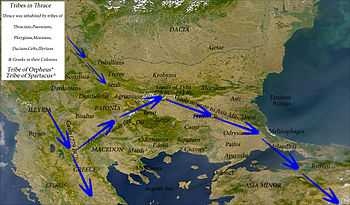
Thracian tribes and heroes.
-

Map of the territory of Philip II of Macedon.
-

Kingdom of Lysimachus and the Diadochi.
-
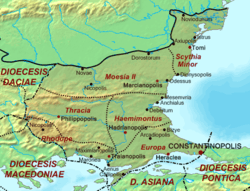
Map of the Diocese of Thrace (Dioecesis Thraciae) c. 400 AD.
See also
- Paeonia (kingdom)
- Dacians
- List of rulers of Thrace and Dacia
- Thrace
- Dacia
- Thracology
- List of Thracian tribes
- Odrysian kingdom
- Skudra
- Achaemenid Empire
- Thracian language
- Thracian mythology
- Cimmerians
- Thraco-Cimmerian
- Thraco-Dacian
- Thraco-Illyrian
- Thraex
- Tiras
- Albanians
- Bulgarians
References
- ↑ Christopher Webber, Angus McBride (2001). The Thracians, 700 BC–AD 46. Osprey Publishing. ISBN 1-84176-329-2.
- ↑ Boardman, John (1970). The Cambridge Ancient History, Volume 3, Part 1. Cambridge University Press. p. 836. ISBN 0-521-85073-8.
- ↑ Navicula Bacchi – Θρηικίη (Accessed: October 13, 2008).
- ↑ John Boardman, I.E.S. Edwards, E. Sollberger, and N.G.L. Hammond. The Cambridge Ancient History, Volume 3, Part 2: The Assyrian and Babylonian Empires and Other States of the Near East, from the Eighth to the Sixth Centuries BC. Cambridge University Press, 1992, p. 597. "We have no way of knowing what the Thracians called themselves and if indeed they had a common name... Thus the name of Thracians and that of their country were given by the Greeks to a group of tribes occupying the territory..."
- ↑ Lemprière and Wright, p. 358. "Mars was father of Cupid, Anteros, and Harmonia, by the goddess Venus. He had Ascalaphus and Ialmenus by Astyoche; Alcippe by Agraulos; Molus, Pylus, Euenus, and Thestius, by Demonice the daughter of Agenor. Besides these, he was the reputed father of Romulus, Oenomaus, Bythis, Thrax, Diomedes of Thrace, &c."
- ↑ Euripides, p. 95. "[Line] 58. 'Thrace's golden shield' – One of the names of Ares was Thrax, he being the Patron of Thrace. His golden or gilded shield was kept in his temple at Bistonia there. Like the other Thracian bucklers, it was of the shape of a half-moon ('Pelta'). His 'festival of Mars Gradivus' was kept annually by the Latins in the month of March, when this sort of shield was displayed."
- ↑ Hoddinott, p. 27.
- ↑ Casson, p. 3.
- ↑ John Boardman, I.E.S. Edwards, E. Sollberger, and N.G.L. Hammond. The Cambridge Ancient History, Volume 3, Part 1: The Prehistory of the Balkans, the Middle East and the Aegean World, Tenth to Eighth Centuries BC. Cambridge University Press, 1982, p. 53. "Yet we cannot identify the Thracians at that remote period, because we do not know for certain whether the Thracian and Illyrian tribes had separated by then. It is safer to speak of Proto-Thracians from whom there developed in the Iron Age..."
- ↑ The catalogue of Kimbell Art Museum's 1998 exhibition Ancient Gold: The Wealth of the Thracians indicates a historical extent of Thracian settlement including most of the Ukraine, all of Hungary and parts of Slovakia. (Kimbell Art – Exhibitions)
- ↑ Simon Hornblower and Antony Spawforth. The Oxford Classical Dictionary. Oxford University Press, 1996, p. 1515. "From the 8th century BC the coast Thrace was colonised by Greeks."
- ↑ Susan Wise Bauer. The History of the Ancient World: From the Earliest Accounts to the Fall of Rome. W.W. Norton & Company, 2007, p. 517. "Megabazus turned Thrace into a new Persian satrapy, Skudra."
- ↑ The Oxford Classical Dictionary by Simon Hornblower and Antony Spawforth, ISBN 0-19-860641-9, page 1514,"The kingdom of the Odrysae, the leading tribe of Thrace extented in present-day Bulgaria, Turkish Thrace (east of the Hebrus) and Greece between the Hebrus and Strymon except for the coastal strip with its Greek cities."
- ↑ 14.0 14.1 "The Thracians, 700 BC - AD 46". Retrieved 24 December 2014.
- ↑ 15.0 15.1 15.2 15.3 15.4 "A Companion to Ancient Macedonia". Retrieved 17 December 2014.
- ↑ The Oxford Classical Dictionary by Simon Hornblower and Antony Spawforth,ISBN 0-19-860641-9,"page 1515,"The Thracians were subdued by the Persians by 516"
- ↑ "Persian influence on Greece (2)". Retrieved 17 December 2014.
- ↑ Herodotus. Histories, Book V.
- ↑ John Boardman, I.E.S. Edwards, E. Sollberger, and N.G.L. Hammond. The Cambridge Ancient History, Volume 3, Part 2: The Assyrian and Babylonian Empires and Other States of the Near East, from the Eighth to the Sixth Centuries BC. Cambridge University Press, 1992, p. 612. "Thrace possessed only fortified areas and cities such as Cabassus would have been no more than large villages. In general the population lived in villages and hamlets."
- ↑ John Boardman, I.E.S. Edwards, E. Sollberger, and N.G.L. Hammond. The Cambridge Ancient History, Volume 3, Part 2: The Assyrian and Babylonian Empires and Other States of the Near East, from the Eighth to the Sixth Centuries BC. Cambridge University Press, 1992, p. 612. "According to Strabo (vii.6.1cf.st.Byz.446.15) the Thracian -bria word meant polis but it is an inaccurate translation."
- ↑ Mogens Herman Hansen. An Inventory of Archaic and Classical Poleis: An Investigation Conducted by The Copenhagen Polis Centre for the Danish National Research Foundation. Oxford University Press, 2005, p. 888. "It was meant to be a polis but this was no reason to think that it was anything other than a native settlement."
- ↑ Christopher Webber and Angus McBride. The Thracians 700 BC-AD 46 (Men-at-Arms). Osprey Publishing, 2001, p. 1. "They lived almost entirely in villages; the city of Seuthopolis seems to be the only significant town in Thrace not built by the Greeks (although the Thracians did build fortified refuges)."
- ↑ http://eprints.jiia.it:8080/148/1/Luca_dacian-warriors.pdf
- ↑ D. Samsaris, The Hellenization of Thrace during the Greek and Roman Antiquity (Diss. in Greek), Thessaloniki 1980
- ↑ D. Samsaris, Les Thraces dans l' Empire romain d' Orient (Le territoire de la Grece actuelle). Etude ethno-demographique, sociale, prosopographique et anthroponymique, Jannina 1993
- ↑ Al. Fol, Les Thraces dans l' Empire romain d' Occident (I-III siecle), GSU-FIF Sofia 1965, 1968, 1969
- ↑ D. Samsaris,Relations entre le peninsule Balkanique et l' Afrique romaine (Population et onomastique balkanique en Afrique), "L' Africa Romana", Sassari 1988, p. 403-430
- ↑ D. Samsaris, Les Thraces dans l' Empire romain d' Orient (Asie Mineure, Syrie, Palestine et Arabie), Dodona 19 (1), 1989, p. 5-30
- ↑ Christopher Webber and Angus McBride. The Thracians 700 BC-AD 46 (Men-at-Arms). Osprey Publishing, 2001, p. 1. "Perhaps the prospect of getting to the spoils explains Thucydides VII, 29: `For the Thracian race, like all the most bloodthirsty barbarians, are always particularly bloodthirsty when everything is going their own way.'
- ↑ Duncan Head and Ian Heath. Armies of the Macedonian and Punic Wars 359 BC to 146 BC: Organisation, Tactics, Dress and Weapons. Wargames Research Group, 1982, p. 51.
- ↑ Plato. The Republic: "Take the quality of passion or spirit;--it would be ridiculous to imagine that this quality, when found in States, is not derived from the individuals who are supposed to possess it, e.g. the Thracians, Scythians, and in general the northern nations;"
- ↑ Plato. Laws: "Are we to follow the custom of the Scythians, and Persians, and Carthaginians, and Celts, and Iberians, and Thracians, who are all warlike nations, or that of your countrymen, for they, as you say, altogether abstain?"
- ↑ Polybius. Histories, 27.12.
- ↑ Tacitus. The Annals: "In the Consulship of Lentulus Getulicus and Caius Calvisius, the triumphal ensigns were decreed to Poppeus Sabinus for having routed some clans of Thracians, who living wildly on the high mountains, acted thence with the more outrage and contumacy. The ground of their late commotion, not to mention the savage genius of the people, was their scorn and impatience, to have recruits raised amongst them, and all their stoutest men enlisted in our armies; accustomed as they were not even to obey their native kings further than their own humour, nor to aid them with forces but under captains of their own choosing, nor to fight against any enemy but their own borderers."
- ↑ Polyaenus. Strategems. Book 7, The Thracians.
- ↑ Strabo. History, 9.401 (9.2.4).
- ↑ Polyaenus. Strategems. Book 7, Clearchus.
- ↑ Christopher Webber and Angus McBride. The Thracians 700 BC-AD 46 (Men-at-Arms). Osprey Publishing, 2001, p. 6.
- ↑ 39.0 39.1 Zofia Archibald. The Odrysian Kingdom of Thrace: Orpheus Unmasked (Oxford Monographs on Classical Archaeology). Clarendon Press, 1998, p. 100.
- ↑ Christopher Webber and Angus McBride. The Thracians 700 BC-AD 46 (Men-at-Arms). Osprey Publishing, 2001, p. 7.
- ↑ Christopher Webber and Angus McBride. The Thracians 700 BC-AD 46 (Men-at-Arms). Osprey Publishing, 2001, p. 34.
- ↑ Herodotus (trans. G.C. Macaulay). The History of Herodotus (Volume II). "Of the other Thracians the custom is to sell their children to be carried away out of the country; and over their maidens they do not keep watch, but allow them to have commerce with whatever men they please, but over their wives they keep very great watch."
- ↑ Beth Cohen (ed.) Not the Classical Ideal: Athens and the Construction of the Other in Greek Art. Leiden, 2000 pp. 370-375. (Online)
- ↑ Cardos, G., Stoian V., Miritoiu N., Comsa A., Kroll A., Voss S., Rodewald A., p. 246. "Computing the frequency of common point mutations of the present-day European population with the Thracian population has resulted that the Italian (7.9 %), the Alban (6.3 %) and the Greek (5.8 %) have shown a bias of closer genetic kinship with the Thracian individuals than the Romanian and Bulgarian individuals (only 4.2%)."
- ↑ Poulianos, Aris N., 1961, The Origin of the Greeks, Ph.D. thesis, University of Moscow, supervised by F.G.Debets
- ↑ Sevasti Trubeta, Physical Anthropology, Race and Eugenics in Greece (1880s–1970s) BRILL 2013, pp. 196-201 Online
- ↑ Most likely he was of Thraco-Roman origin, believed so by Herodian in his writings,(Herodian, 7:1:1-2) and the references to his "Gothic" ancestry might refer to a Getae origin (the two populations were often confused by later writers, most notably by Jordanes in his Getica), as suggested by the paragraphs describing how "he was singularly beloved by the Getae, moreover, as if he were one of themselves" and how he spoke "almost pure Thracian".(Historia Augusta, Life of Maximinus, 2:5)
- ↑ "Bulgarian Archaeologists Make Breakthrough in Ancient Thrace Tomb". Novinite. March 11, 2010. Retrieved April 3, 2010.
- ↑ "Bulgarian Archaeologists Uncover Story of Ancient Thracians' War with Philip II of Macedon". Novinite. June 21, 2011. Retrieved June 24, 2011.
Sources
- Marazov, Ivan (ed.). Ancient Gold: The Wealth of the Thracians. NY: Harry N. Abrams Inc., 1998. Texts by Marazov, Ivan; Venedikov, Ivan; Fol, Alexander; Tacheva, Margarita. ISBN 9780810919921.
- Best, Jan and De Vries, Nanny. Thracians and Mycenaeans. Boston, MA: E.J. Brill Academic Publishers, 1989. ISBN 90-04-08864-4.
- Cardos, G., Stoian V., Miritoiu N., Comsa A., Kroll A., Voss S., Rodewald A. "Paleo-mtDNA analysis and population genetic aspects of old Thracian populations from South-East of Romania". Romanian Journal of Legal Medicine 12(4), pp. 239–246, 2004. (Article)
- Casson, Lionel. "The Thracians". The Metropolitan Museum of Art Bulletin, New Series, Vol. 35, No. 1, (Summer, 1977), pp. 2–6.
- Hoddinott, Ralph F. The Thracians. Thames & Hudson, 1981. ISBN 0-500-02099-X.
External links
| Wikimedia Commons has media related to Ancient Thrace and Ancient Thracians. |
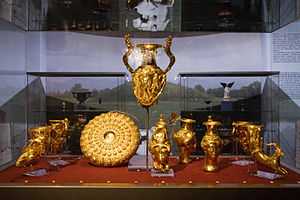
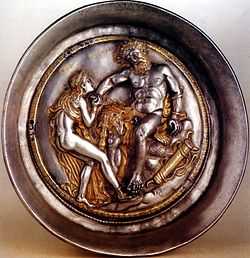
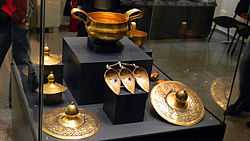
.jpg)
